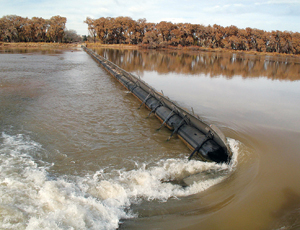Industry sources describe the funds provided in the final stimulus package for the environmental sector as a good start that could help the Obama administration meet its goal of jumpstarting the economy by creating and saving more jobs. But they acknowledge that the $20.6 billion allocated for environmental projects ranging from water and wastewater infrastructure to levees, Superfund and Dept. of Energy nuclear cleanup falls far short of what is needed to address current and long-term needs.

More flexibility has been provided to states in some cases to get projects off the ground quickly. But some of the funding comes with strings attached, and projects that do not break ground within a specific time frame may see their dollars disappear as funds are reallocated to other projects on their states’s priority list.
Funding for drinking-water and wastewater infrastructure both received big boosts, with $2 billion allocated for the drinking-water state revolving fund and $4 billion for the clean-water SRF.
"It’s certainly a dramatic increase in the funding that has historically gone into the SRF," says Peter Tunnicliffe, president of the Water Design-Build Council and a senior vice president at Cambridge, Mass.-based Camp Dresser and McKee. For fiscal 2008, Congress appropriated approximately $689 million for the Clean Water SRF and $842 million for the drinking-water fund. But with large gaps between funding levels for wastewater and drinking-water projects and what is actually needed, the new funding "will help, but it will only scratch the surface of the needs," Tunnicliffe adds.
Lawmakers included several provisions to ensure that projects would move forward more expeditiously.
"There’s always been a debate about whether public-works projects and water-infrastructure projects are good candidates for stimulus because of the time it takes to get these projects up," says Tim Williams, managing director of government affairs at Water Environment Federation, an water education and advocacy group.
One provision drops the 20% matching requirement for states drawing on the SRF "to expedite use of the funds," the bill report’s language states. "We were pleased to see that requirement waived," says Tommy Holmes, legislative director at the American Water Works Association. "Otherwise, state legislatures would have had to meet" and come up with the funding to match 20% of an SRF loan.
Conferees also included language directing the administrator of the Environmental Protection Agency to shift funding to other projects when a project is not under contract or under construction within 12 months. Moreover, priority will be given to projects already on state priority lists that are ready to move to construction within 12 months. Williams says municipalities looking to find funding for projects should get to know their state SRF administrator. "The main thing you need to do is make sure you’re on the state priority list," he adds.
Some industry sources suggest municipalities use a design-build delivery method to get more people working sooner. "A design-build approach allows municipal owners to get into construction for most of their capital projects within 120 days from notice to proceed," Tunnicliffe says. "Not only do you stimulate the engineering market, you get craftworkers mobilized much faster."

Drinking water/clean- water state revolving funds: $6 billion
Corps of Engineers flood control and civil Works: $4.6 billion
Dept. of Energy: $6 billion
Also: Superfund cleanup; rural and western water projects
The package requires at least 20% of each SRF be devoted to green-water or energy-efficiency projects. These may include a more energy-efficient power source at a wastewater treatment plant, a waste-to-energy plant or stormwater runoff mitigation. States may use less than 20% of their SRF funding for green projects only if they do not receive enough applications.
The stimulus also provides $1.3 billion to the Dept. of Agriculture for rural-water and waste-disposal facilities, as well as $1 billion to the Bureau of Reclamation for water projects.
Disappointments
The $4.6 billion of the package dedicated to the U.S. Army Corps of Engineers is "a step in the right direction but disappointing," considering the Corps’ $61- billion backlog of authorized but unfunded work and $250 million needed for the Mississippi Rivers and Tributaries program, says Rob Vining, vice president of HNTB Federal Services Corp., Arlington, Va., who was civilian chief of the Corps’ program management division for civil works from 2001 to 2005.
"The Corps’ number of what they have shovel-ready is in the $9-billion to $12-billion range, and they got less than half of that," Vining says. Despite 2008’s record floods and levee failures in Washington state, widespread flooding in the Midwest and the damage caused by Hurricanes Gustav and Ike, "so little of the stimulus package is addressing critical water infrastructure we need," Vining says.

Remediation
Drinking Water SRF: $2 billion
Clean Water SRF: $4 billion.
Some of the funds come with string attached. If states do not use all of their clean- or drinking-water-SRF funds on certain projects, the money can be reallocated.
D. Wayne Klotz, president of the American Society of Civil Engineers, agrees. "Inland waterways, levees, dams and other water resources are vital to a healthy water supply, efficient goods movement, reliable flood control and safe recreation," he says. "While the economic recovery legislation is an encouraging sign that Washington has recognized the importance of investing in such infrastructure, even with the stimulus funding there still remains a significant gap between the needed investment and the proposed funding. This is the beginning of the journey, not the end."
Regardless of the size of the package, the primary challenge will be obligating and spending the money within two years, says Laurence Bory, vice president and national director of federal government relations for HDR Engineering Inc., Alexandria, Va. The Corps will likely use the $4.6 billion to address its huge backlog of maintenance on locks and dams, dredging or stockpiling construction materials like steel. But the restrictions do not allow the Corps to use the funds on huge projects like the Everglades and Sacramento Delta where engineering has not been done, Bory says.
Furthermore, the Corps will likely receive another $4 billion or $5 billion from the soon-to-be-passed Omnibus Public Land Management Act of 2009 and a comparable amount in the President’s budget that must be approved by September, Bory says. "The Corps will need extra resources to move that stimulus money because they will likely have another $5 billion coming right behind it," Bory says.
| STATE | $ INVESTMENT |
|---|---|
| New York | 431,570,997 |
| California | 279,639,756 |
| Ohio | 220,115,115 |
| Texas | 178,709,751 |
| Illinois | 176,834,988 |
| Michigan | 168,121,008 |
| New Jersey | 159,778,179 |
| Pennsylvania | 154,879,758 |
| Massachusetts | 132,750,486 |
| Florida | 131,981,850 |
| SOURCE: COMMITTEE ON TRANSPORTATION AND INFRASTRUCTURE | |
Conferees kept in $6 billion for Dept. of Energy nuclear-cleanup projects. The House-passed version had only included $500 million, but Sen. Patty Murray (D-Wash.) added $6.4 billion for nuclear cleanup in the Senate legislation, $6 billion of which carried over to the final package.
Ines Triay, acting head of the Energy Dept.’s environmental management program, said on Feb. 12 that the stimulus funds will bolster the work that is planned under DOE’s "2015 Vision" program, which is designed to reduce the footprint of Hanford in Washington state and other major cleanup sites by up to 90% over the next six years.
Tight Focus
Triay said DOE will focus the $6 billion of stimulus funds on four major projects: Hanford’s so-called river-corridor and central-plateau cleanup contracts; the Idaho National Laboratory; the Oak Ridge site in Tennessee; and the Savannah River site in South Carolina. Some of the stimulus dollars will also go to smaller sites, Triay said.
Efforts to clean up and close down Hanford’s aging radioactive-waste tanks would not likely receive a large boost in funding, but some of the program’s surrounding infrastructure would get significant aid. This infrastructure will help transfer the tank waste to the plant that DOE is building at Hanford to vitrify the waste into glasslike logs. DOE hopes to complete the vitrification plant by 2019. "We have focused on projects which we can complete," Triay said.
In addition, the bill provides $1.2 billion for EPA cleanup, including Superfund remediation.



Post a comment to this article
Report Abusive Comment